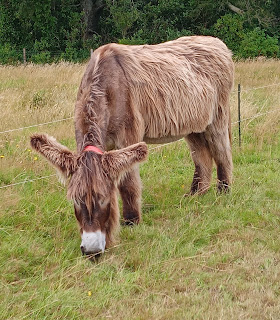A spectacular walk with lot's of interest for what is my 400th blog post. The weather forecast is a shocker, undeterred we still make the journey. I seem to have almost as much clothing as I took on holiday down to Devon. All sorts of gear, long trousers, waterproof over trousers, a dry pair of trousers for changing in to. A light fleece, a light rain jacket, a heavy rain jacket. And so the list goes on.......
We are starting the walk in the heart of The Peak District from the 'Robin Hood' pub at Baslow. The pub is strictly parking for customers only.
We park next door in the National Trust car park where the pay machine is out of order. Not much we can do in such a situation, except to thank our good luck and carry on.
We are walking in an anti-clockwise direction and it's an uphill start. The good news is that the rain forecast is holding off.
 |
The Nelson Monument monument consists of a three-metre tall grit-stone column with a 30 cm ball on top. It was erected in 1810 in honour of Admiral Lord Nelson, who had died at the Battle of Trafalgar in 1805, by a local businessman from Baslow called John Brightman.
Before we reach the Wellington monument there are some serious Highland Cattle on Baslow Edge to negotiate. They seem very placid but I'm taking no chances and will walk around them giving them a wide berth.
The Wellington Monument was erected in 1866 to commemorate a visit by the Duke of Wellington to the moor.
Baslow is a lovely village on the edge of the Chatsworth Estate. The village is overlooked by the dramatic grit-stone edges of Curbar Edge and Baslow Edge, and the River Derwent runs through it,
 |
| Highland Cattle |
 |
 |
| The Wellington Monument |
During mid August and early September, the moors are carpeted in a rich mixture of purple and pink flowers of Heather.
It really is spectacular particularly against the backdrop of the hills.
We have now entered Chatsworth Park and Estate. The 1,000-acre park on the banks of the River Derwent was chiefly designed not surprisingly by Lancelot 'Capability' Brown in the 1760s. This guy seems to have had a hand in all the major garden designs.
He actually designed over 170 parks including the amazing Stowe Landscape Gardens. As well as Warwick Castle, Blenheim, Highclere, Kew Gardens and Harewood House. No wonder they called him 'Capability'!
The picture on the left shows Chatsworth in the distance amongst the Derbyshire Dales.
The park contains historic and modern architecture and art including James Paine's bridges and mill and Queen Mary's Bower.Chatsworth House is home to the Duke and Duchess of Devonshire, and has been passed down through 16 generations of the Cavendish family.
Looming above the trees is the highly impressive 'Hunting Tower.Standing on the escarpment 400 feet above Chatsworth House,on the edge of Stand Wood it is an imposing sight It was completed around 1582 for Bess of Hardwick, ancestress of the Dukes of Devonshire. It is now available to stay in as a holiday rental. A local was telling me it costs in excess of a thousand pounds per night though....
 |

 |
Walking along the banks of the River Derwent a Dipper is flitting between the rocks. It is soon joined by it's partner before disappearing downstream.Further on there is a flash of blue and Kingfisher flies under the bridge that marks the exit from the park.There is also a large Heron fishing patiently on the opposite bank.
It is now a steep climb up towards Beeley Hilltop and Hell and Hell Bank Plantation. It is here we take an unscripted detour to try and find a stone circle marked on the map.The search involved crossing a marsh which was difficult and wet and was all to no avail. The stone circle was not to be revealed.
 |
| Archie at Hob Hurst's House |
Our next off piste excursion is more successful though! Hob Hurst's House sounds very intriguing and conjures up an image of a Hobbit like abode set amongst the hills. Even more so when you find out that the name refers to a common folklore character such as an Elf or a Giant, thought to live in a stone circle or a barrow.
 |
It is a relatively small earthworks actually and not anywhere near as spectacular as I had hoped for. It does though date back to the bronze age, making it more than 3,000 years old. There are several other prehistoric cairns on the moors of a similar age.
The last part of the walk takes us past Gibbet Moor. Its highest point is 295 metres (968 ft) above sea level.A gibbet was a wooden structure (like a gallows) where the dead bodies of criminals were hung on display.
The last person to be gibbeted alive in England was a vagrant who was
begging for food around Baslow and killed a woman in her cottage. The
murderer was left to die in a gibbet cage on Gibbet Moor in the 17th
century
We have a slight mishap at the end when an attempted shortcut takes us down the wrong route. We back track and take the planned rout which is on the edge of the busy main road.
Safely back to the start point and amazingly still dry! We have covered just over 12 miles and it has been a great walk. Just time for a refreshing pint at The Robin Hood Inn. The pint in question being a very tasty 'Jennings' 'Night Vision' a dark session beer at 3.5%.

























































